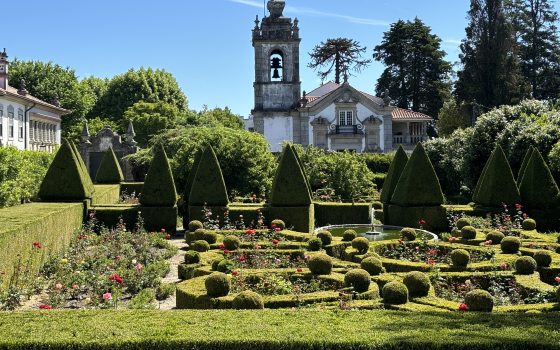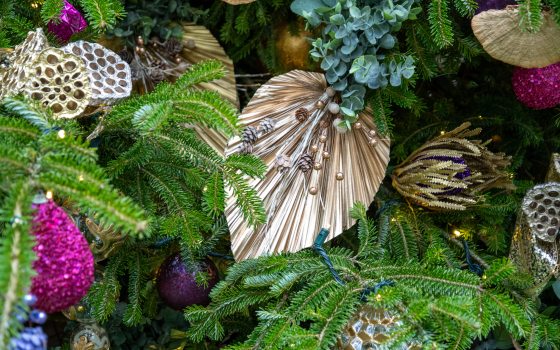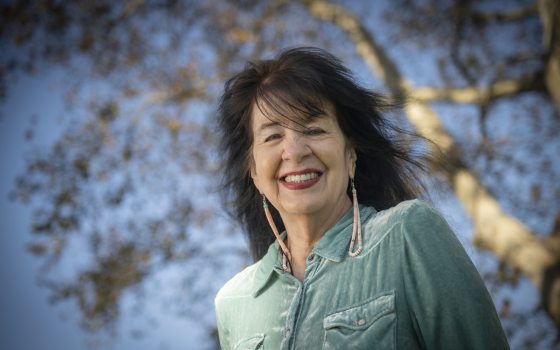One of the greatest benefits of the Longwood Professional Horticulture Program—a two-year, tuition-free program that trains and prepares future horticulturists for successful careers—is an educational trip abroad, planned and funded by the students. The Professional Horticulture class of 2024 has spent the past two years organizing and holding plant sales—selling numerous plants, many of which we grew ourselves—and last month we enjoyed the fruits of our labor with our trip to Portugal, a destination inspired by the Mediterranean garden design of the nearly completed West Conservatory of Longwood Reimagined: A New Garden Experience. Planned by our class, this trip serves as a capstone of our two-year experience, and provides us with new skills and a fresh point of view as gardeners—which we bring with us back to Longwood, and on to wherever we may go next. Follow along as we share where we traveled, what we saw, and what we’ll always remember from our experience.
It was a jam-packed whirlwind of a trip. In seven days, we visited three major locales—Madeira Island, Porto, and Lisbon—with two or three gardens or site visits each and every day. We chose our destinations following the theme of exploring wild vs. tamed spaces: in preparation for the West Conservatory, we wanted to study how Mediterranean plants grow naturally in (relatively) untamed spaces like national parks and restorations, and how they are used in more formal garden settings. Such close studies of plants are how we horticulturists create stunning spaces and landscapes, allowing guests to feel immersed in a magical new world. In our variety of visits on this trip, we gained so much inspiration that we’ve carried with us back home.
Madeira
We began our trip on the absolutely gorgeous island of Madeira, which is located far to the southwest of Portugal and west of Morocco. The island has a warmer subtropical climate than the mainland while still being Mediterranean, allowing for truly phenomenal plant diversity and display. We put our theme into practice on our very first day: we experienced the crisp formal lines of mosaiculture at Jardim Botânico da Madeira, and the wild beauty of century-old Dracaena draco trees at Núcleo Dragoeiros das Neves. This threatened species is a close relative of the houseplant and ornamental dracaenas, but its height and umbrella-like habit make it a unique Macaronesian specimen.
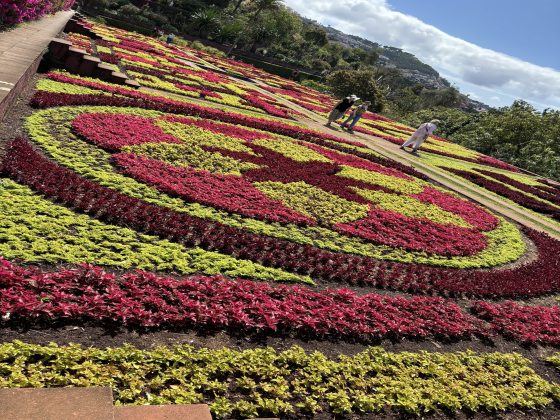
Mosaiculture, the art of using bedding plants to create complex designs and shapes, on display at Jardim Botânico da Madeira. Photo by Charli Klein.
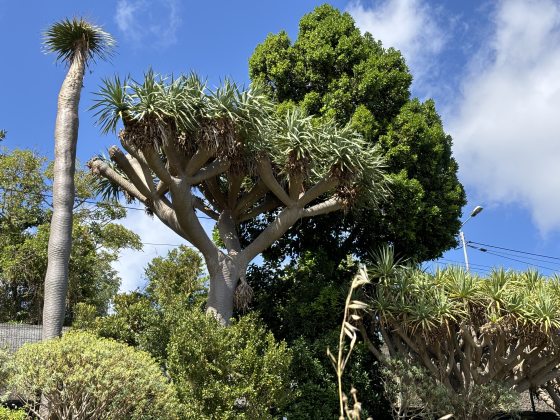
Dracaena draco, or dragon tree, at Núcleo Dragoeiros das Neves. This culturally important native species is International Union for Conservation of Nature (IUCN)- threatened, but protected in this park. Photo by Charli Klein.
The following day, we were fortunate to visit Quinta da Boa Vista, the orchid nursery of plantsman and orchid specialist Patrick Garton, who explained to us that the best way to care for an orchid is to study the way it grows in nature. Garton was a font of knowledge and was only too happy to share that knowledge with us. Among his massive collection of orchids, he explained the differing substrate and water needs of different genera, and the process and challenges of breeding new varieties—something we have some experience with, as we have studied and worked with Longwood’s own orchid specialist Greg Griffis during our time at Longwood.
Later, we again explored a perfect juxtaposition between wild and tamed by visiting an ancient laurel forest and the Monte Palace Gardens. The laurel forest (Laurisilva) of Levada dos Balcões is largely primary forest, and is a designated UNESCO World Heritage Site thanks to its 76+ endemic plant species and role in preserving Madeira’s hydrology. We hiked up a mountaintop for a beautiful view of that forest and the way it trickles into Madeira’s cliffside towns. Conversely, at Monte Palace Gardens, we experienced horticultural and architectural wonders—from plant species from all over the world, to some of the finest examples of 15th and 16th century Portuguese tilework.
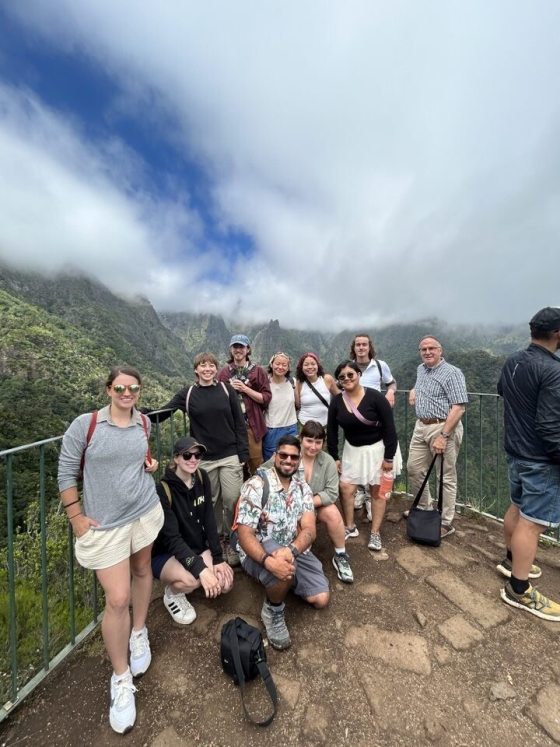
The Professional Horticulture Class of 2024 and Longwood Associate Director of Collections Tony Aiello, overlooking the laurisilva at Levada dos Balcões. Photo by Andrew Gurka. Standing (from left): Caroline Colino, Charli Klein, Sammy Winderman, Kelsey Chai, Abi Urena, Victoria Fuentes, Noah Meanix, and Tony Aiello. Sitting (from left): Madison Claydon, Carlos Rodriguez, and Sam Paine.
Madeira truly encapsulated the theme of our trip. From stunning and well-preserved wild spaces to beautifully manicured gardens, Portugal’s care for their environment and stewardship of their plants, both endemic and exotic, was clear. We had already learned so much—but there were still two more cities and countless other sights to see!
Porto
After an early-morning flight, we started our time on the mainland strong by visiting Serralves Park, a museum-garden complex. Serralves’ head gardener Ricardo Bravo was kind enough to give us a tour and talk us through his development and project goals for the park. One uniquely special feature of this garden was the newly built treetop walk, a wheelchair-accessible walkway that gives guests a bird’s eye view of the forest and park. The walkway even featured an outdoor classroom and was partly constructed of lumber from onsite—although no trees were felled to make space for the walkway. Next was a trip to the Jardim Botânico do Porto, a small but mighty garden in the heart of the city, where we enjoyed a variety of garden styles, from rose garden to bromeliads to pond.
The next morning we traveled to Quinta da Aveleda, a romantic garden of the 19th century, where we gained so much inspiration for transporting a guest to a whimsical new world. Mountain laurels, camellias, the culturally important and economically vital cork oak, and an adorable goat hutch were the highlights here. From there we journeyed to Quinta da Gricha in the Douro Valley, Portugal’s vineyard and port wine capital and another UNESCO World Heritage Site, to learn about the winemaking process and the care and keeping of a vineyard. The valley has been tended to by generational wineries for upwards of two millennia, and they have long since perfected the science of viticulture.
Our final stop near Porto was Santar Garden Village, another example of the utmost formal gardening in Portugal, but with a unique history: a group of estate owners decided to revitalize their village by removing the barriers between their estates, restoring their gardens, and coming together to create an entire garden village. This lovely garden showcased the power of community, which was reminiscent of our Student Exhibition Garden theme of community at Longwood (on view now!), and was a sweet place to say goodbye to Porto.
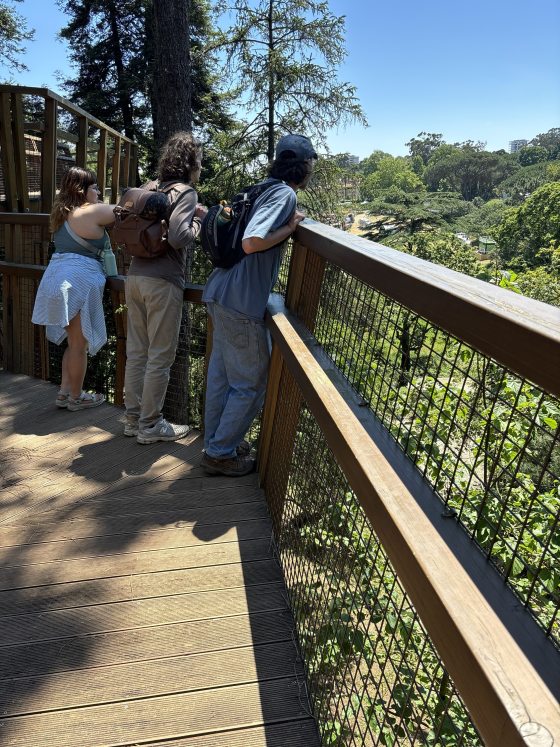
Students overlook Serralves Park from the treetop walkway. Photo by Charli Klein.
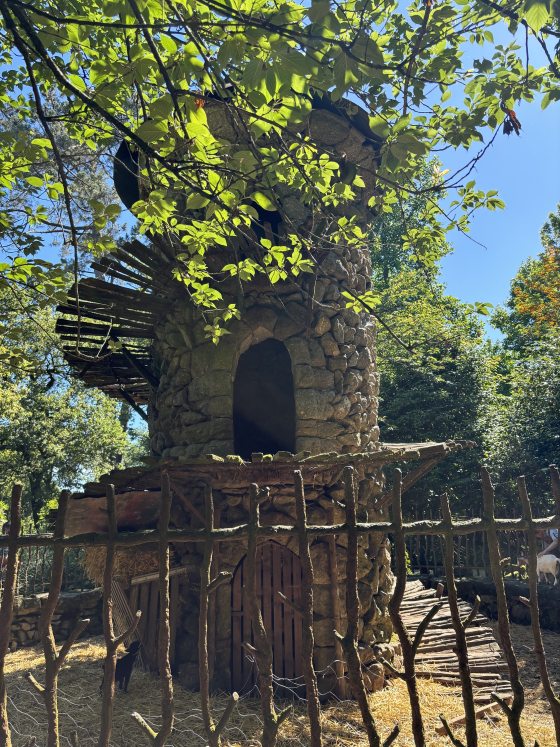
A lovely, English-inspired home for goats at Quinta da Aveleda. Photo by Charli Klein.
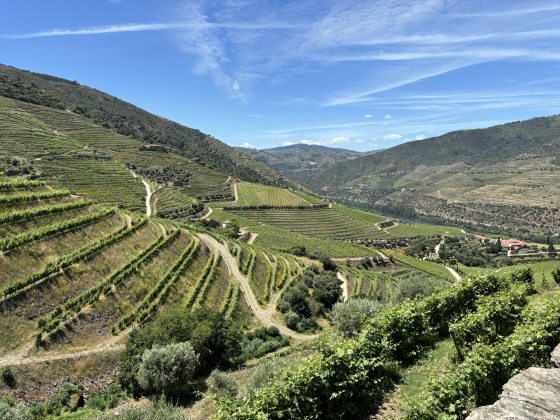
The many vineyards of the Douro Valley, another UNESCO World Heritage Site, where grapes for table wines and Portugal’s signature port wine are produced. Photo by Charli Klein.
Lisbon
We kicked off our explorations in Lisbon with a bit of time to explore this magical city. Pastel-colored buildings, ornate tilework, and the architecture of the Museum of Art, Architecture and Technology (MAAT) Museum complex sweeping over the waterfront were strong introductions to Lisbon.
Next was a visit to the Jardim Botânico Tropical, a national monument that was an important pillar of the 1940 World’s Fair and serves as a teaching garden today. We enjoyed many specimens of cactus, agave, bromeliads, and a massive Ficus macrophylla tree from Australia. Then, we moved back into gardens most formal at Fronteira Palace, another national monument where 17th century architecture and tilework have been extensively preserved, and boxwood hedges and roses create a winding maze.
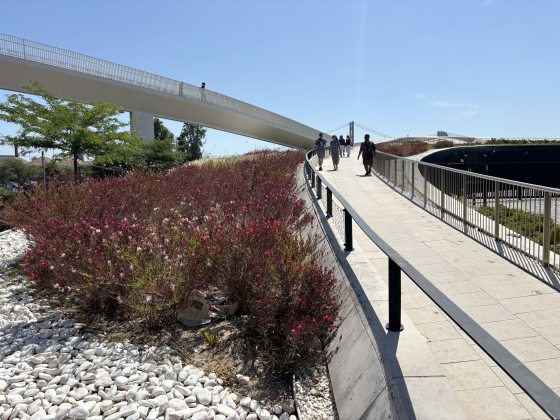
Vibrant pink blossoms of the United States’ own gaura (Oenothera lindheimeri) line the garden walkway of the MAAT Museum. Photo by Charli Klein.
The next morning we continued our cultural tours in Sintra, another UNESCO World Heritage Site, honored for its concentration and conservation of 19th century Romantic period architecture and gardens. At Convento Dos Capuchos, a 16th century monastery, we experienced a serene atmosphere and felt transported back in time amongst the well-preserved ancient forest and austerity of the monastery.
Our final destination was, fittingly, one last perfect embodiment of the theme of wild and tamed spaces. At Monserrate Palace and Park, we were lucky enough to meet with the park’s forester and two generations of landscape architects that have worked on the site. The site’s history as an estate and garden dates back to at least the 16th century, but the palace as it stands today was commissioned by an English art collector in the 19th century. The palace’s design was heavily influenced by Gothic and Indian styles, but the garden is pure Romantic in nature. After falling into varying states of disrepair in the ensuing centuries, the palace and park were restored to their former glory within the past few decades.
The garden was wisely designed based on the hilly site’s existing microclimates, which allowed for a huge diversity of plants from all over the world to thrive here. It was also divided into habitat types and geographic areas, allowing for impressive plant collections and a truly transportive experience for the guest. We meandered through a restored forest of tree ferns, trailing downhill from a streambank to a waterfall view, to a constructed ruin built by those 19th century Romantics into the side of a massive Ficus, covered by its adventitious roots. Numerous striking species of fuchsia and begonia lined the forested pathways and dangled overhead. A pond ecosystem full of vivid pink waterlilies and surrounded by palms and huge Araucaria trees transitions into a dry Mexican biome uphill. Another echo of home: the towering, tree-like flower spikes of agave, just like Longwood’s own agave in the Conservatory’s Silver Garden that just flowered this summer.
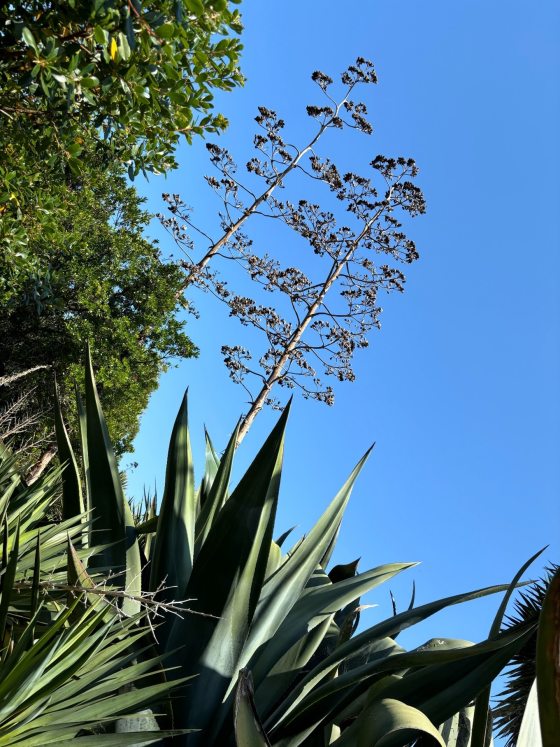
The flowering spikes of Agave americana are a striking form on the skyline. At Longwood, roof panels were removed to allow the inflorescence to bloom in the Silver Garden. Photo by Charli Klein.
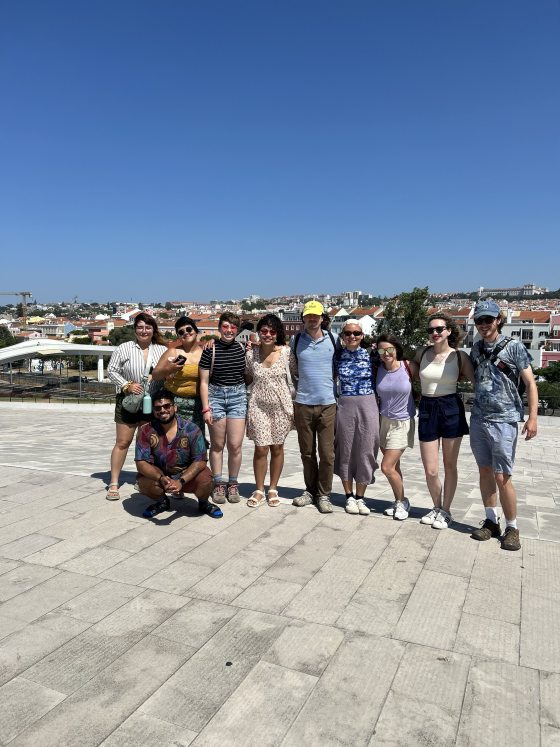
The Professional Horticulture Class of 2024. From left: Sam Paine, Carlos Rodriguez, Victoria Fuentes, Charli Klein, Abi Urena, Noah Meanix, Kelsey Chai, Caroline Colino, Madison Claydon, and Sammy Winderman. Photo by Andrew Gurka.
As we reflect on this once-in-a-lifetime trip, we are grateful for the opportunity to see firsthand, in Portugal, the Mediterranean plant palette that has, in part, inspired the new West Conservatory at Longwood. Come this November, Longwood guests will experience some of the same magic we did in Portugal—and I, for one, can’t wait to see it!
